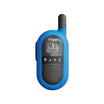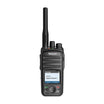The terms "two-way radio" and "walkie talkie" are often used interchangeably in the industry, but there are subtle differences between them. Walkie talkies are typically seen as short-range, license-free devices, often used for personal or recreational purposes. They generally offer basic features like push-to-talk, volume control, and channel selection, with a range that can be limited by terrain and buildings.
On the other hand, two-way radios are used more broadly, including for business applications. These devices usually offer extended range, require a license for operation, and come with advanced features like man down alerts, lone worker functions, selective calling, more channel options, and vibration alerts, enhancing their utility in professional settings.
A key distinction is that walkie talkies are always handheld, allowing for mobility, whereas two-way radios can also include vehicle-mounted or stationary units installed at a desk or in a power supply unit, which are referred to as mobile radios.
In essence, while the core function of transmitting and receiving radio signals is shared, the use case, range, licensing requirements, and features distinguish walkie talkies from two-way radios.
For an extensive selection of two-way radio systems, including those with advanced features like built-in GPS, Bluetooth, active noise cancellation, digital voice playback, and USB ports for programming and data transfer, exploring Talkpod's offerings can provide a comprehensive solution tailored to various operational needs.
On the other hand, two-way radios are used more broadly, including for business applications. These devices usually offer extended range, require a license for operation, and come with advanced features like man down alerts, lone worker functions, selective calling, more channel options, and vibration alerts, enhancing their utility in professional settings.
A key distinction is that walkie talkies are always handheld, allowing for mobility, whereas two-way radios can also include vehicle-mounted or stationary units installed at a desk or in a power supply unit, which are referred to as mobile radios.
In essence, while the core function of transmitting and receiving radio signals is shared, the use case, range, licensing requirements, and features distinguish walkie talkies from two-way radios.
For an extensive selection of two-way radio systems, including those with advanced features like built-in GPS, Bluetooth, active noise cancellation, digital voice playback, and USB ports for programming and data transfer, exploring Talkpod's offerings can provide a comprehensive solution tailored to various operational needs.











































